Difference between revisions of "Photographic studio"
(pic) |
m (Moved Glossary to the top of the page) |
||
| (23 intermediate revisions by 3 users not shown) | |||
| Line 1: | Line 1: | ||
| + | {{glossary}} | ||
{{Flickr_image | {{Flickr_image | ||
| − | |image_source= http://www.flickr.com/photos/uwe_kulick/5462349393/in/pool-camerawiki/ | + | |image_source= http://www.flickr.com/photos/camerawiki/6834942206/in/pool-camerawiki/ |
| − | |image= http://farm6.static.flickr.com/5172/ | + | |image= http://farm8.staticflickr.com/7178/6834942206_b7344ab404_c.jpg |
| + | |image_align= left | ||
| + | |image_text= The studio of Bradley and Rulofson of San Francisco | ||
| + | |image_by= | ||
| + | |image_rights= pd | ||
| + | }} | ||
| + | {{br}}{{Flickr_image | ||
| + | |image_source= http://www.flickr.com/photos/statelibraryofnsw/4382941931/ | ||
| + | |image= http://farm3.staticflickr.com/2694/4382941931_4b08ec5fc4_n.jpg | ||
| + | |image_align= right | ||
| + | |image_text= Sam Hood's studio<ref>see Sam Hood's [http://www.flickr.com/photos/statelibraryofnsw/tags/samhood/ image collection in Library of New South Wales] on Flickr</ref> | ||
| + | |image_by= |image_rights= public domain | ||
| + | }} | ||
| + | The early [[daguerreotype]] photography was optimal for achitecture because many early cameras had a kind of landscape lens which needed usage at small aperture, thus allowing only exposure times of ten minutes even in the sunshine. Soon there was a solution available, the fast [[Petzval lens]] which reduced exposure times to 30 seconds. This was still much time to keep still for the photographic model. [[Photographer]]s had to avoid situations in which wind blew thru hair and dress of the portrayed person, or cold weather caused the model to shiver. Thus closed but light rooms were necessary, often wide rooms with glass roof. The Punch cartoon below shows a cat looking thru the studio's glass roof, the image above even a studio's whole glass roof. Seem to have been typical locations, with the artistic studio or "'''photographic studio'''" in a huge attic. The image above shows that mirrors, reflectors and diffusors may have been used to optimize the light falling onto the model. | ||
| + | |||
| + | Soon exposure times in bright light could be shortened by improving the applied photographic processes, but exposure times were still a few seconds. Thus the studio needed special equipment like chairs with small headrest and mise-en-scène furniture, pillars and stuff which also served as stilt on which the portrayed could rest. Some photographers even offered making photographs with huge background painting behind the portayed. When [[George Raymond Lawrence|"Flashlight Lawrence"]] had made his efforts with [[Flash powder|magnesium powder]] flashes special tripod based studio flashes were developed soon. As well as bright gas lamps and last not least electric lamps. | ||
| + | |||
| + | ===oldtime studio=== | ||
| + | {{Flickr_image | ||
| + | |image_source= http://www.flickr.com/photos/uwe_kulick/5709370691/in/pool-camerawiki | ||
| + | |image= http://farm4.static.flickr.com/3076/5709370691_b59d15c918_m.jpg | ||
| + | |image_align= left | ||
| + | |image_text= [[studio camera]] | ||
| + | |image_by= Uwe Kulick | ||
| + | |image_rights= wp | ||
| + | }} {{Flickr_image | ||
| + | |image_source= http://www.flickr.com/photos/camerawiki/6834942276/in/pool-camerawiki | ||
| + | |image= http://farm8.staticflickr.com/7207/6834942276_dc26226455_m.jpg | ||
| + | |image_align= left | ||
| + | |image_text= head and back rest | ||
| + | |image_by= | ||
| + | |image_rights= pd | ||
| + | }} {{Flickr_image | ||
| + | |image_source= http://www.flickr.com/photos/camerawiki/6834942092/in/pool-camerawiki/ | ||
| + | |image= http://farm8.staticflickr.com/7177/6834942092_58bcb5fa0e_m.jpg | ||
| + | |image_align= left | ||
| + | |image_text= [[Carte de Visite|CDV]] camera | ||
| + | |image_by= | ||
| + | |image_rights= pd | ||
| + | }}{{Flickr_image | ||
| + | |image_source= http://www.flickr.com/photos/uwe_kulick/4296397116/in/pool-camerawiki/ | ||
| + | |image= http://farm3.staticflickr.com/2719/4296397116_059d2102f4_m.jpg | ||
| + | |image_align= left | ||
| + | |image_text= carbon arc lamp | ||
| + | |image_by= | ||
| + | |image_rights= (C) | ||
| + | }}{{Flickr_image | ||
| + | |image_source= http://www.flickr.com/photos/heritagefutures/6781682248/in/pool-camerawiki/ | ||
| + | |image= http://farm8.staticflickr.com/7188/6781682248_471a9075a7_m.jpg | ||
| + | |image_align= left | ||
| + | |image_text= [[portrait lens]] | ||
| + | |image_by= Dirk HR Spennemann | ||
| + | |image_rights= wp | ||
| + | }}{{Flickr_image | ||
| + | |image_source= http://www.flickr.com/photos/uwe_kulick/5486520701/in/pool-camerawiki/ | ||
| + | |image= http://farm6.staticflickr.com/5092/5486520701_24f6ed25e0_m.jpg | ||
| + | |image_align= left | ||
| + | |image_text= studio flash | ||
| + | |image_by= | ||
| + | |image_rights= (C) | ||
| + | }}{{br}} | ||
| + | |||
| + | ===modern studio=== | ||
| + | {{Flickr_image | ||
| + | |image_source= http://www.flickr.com/photos/rborges/3199485591/in/pool-camerawiki | ||
| + | |image= http://farm4.static.flickr.com/3393/3199485591_0bf976ffcb_m.jpg | ||
| + | |image_align= left | ||
| + | |image_text= electronic studio flash<br/>with semi-reflecting umbrella | ||
| + | |image_by= Raphael Borges | ||
| + | |image_rights= wp | ||
| + | }}{{Flickr_image | ||
| + | |image_source= http://www.flickr.com/photos/37460295@N05/5831050129/in/photostream/ | ||
| + | |image= http://farm3.staticflickr.com/2676/5831050129_8bf3eb1182_m.jpg | ||
| + | |image_align= left | ||
| + | |image_text= flash meter | ||
| + | |image_by= Studioesper | ||
| + | |image_rights= (C) | ||
| + | }}{{Flickr_image | ||
| + | |image_source= http://www.flickr.com/photos/zokyo/5097938523/in/pool-camerawiki/ | ||
| + | |image= http://farm2.staticflickr.com/1383/5097938523_07f41e8408_m.jpg | ||
| + | |image_align= left | ||
| + | |image_text= passport camera | ||
| + | |image_by= Zebrio | ||
| + | |image_rights= (C) | ||
| + | }}{{Flickr_image | ||
| + | |image_source= http://www.flickr.com/photos/s-demir/4881244157/in/pool-camerawiki/ | ||
| + | |image= http://farm5.staticflickr.com/4136/4881244157_9841c2fcf1_n.jpg | ||
| + | |image_align= left | ||
| + | |image_text= portrait lens | ||
| + | |image_by= Süleyman Demir | ||
| + | |image_rights= wp | ||
| + | }} | ||
| + | |||
| + | |||
| + | {{br}} | ||
| + | |||
| + | ===The artistic studio === | ||
| + | let's have a look into some studios | ||
| + | {{Flickr_image | ||
| + | |image_source= http://www.flickr.com/photos/uwe_kulick/5462349393/sizes/l/in/pool-camerawiki/ | ||
| + | |image= http://farm6.static.flickr.com/5172/5462349393_9cb483c641_z.jpg | ||
|image_align= left | |image_align= left | ||
|image_text= cartoon from Punch magazine | |image_text= cartoon from Punch magazine | ||
|image_by= John Leech | |image_by= John Leech | ||
|image_rights= with permission | |image_rights= with permission | ||
| + | }} | ||
| + | {{Flickr_image | ||
| + | |image_source= http://www.flickr.com/photos/thorpehamlet/7227543590/in/pool-camerawiki | ||
| + | |image= http://farm8.staticflickr.com/7242/7227543590_85fc2b4e7f_z.jpg | ||
| + | |image_align= left | ||
| + | |image_text= Photographic Saloon, East End of London, 1861 by Henry Mayhew | ||
| + | |image_rights= (C) | ||
}}{{br}} | }}{{br}} | ||
| − | |||
| − | |||
| − | |||
| − | |||
| − | |||
| − | |||
| − | |||
| − | |||
| − | + | ==References and Links== | |
| + | <REFERENCES/> | ||
[[Category:Professional photography]] | [[Category:Professional photography]] | ||
[[Category:Essayistic]] | [[Category:Essayistic]] | ||
Latest revision as of 03:46, 23 March 2023
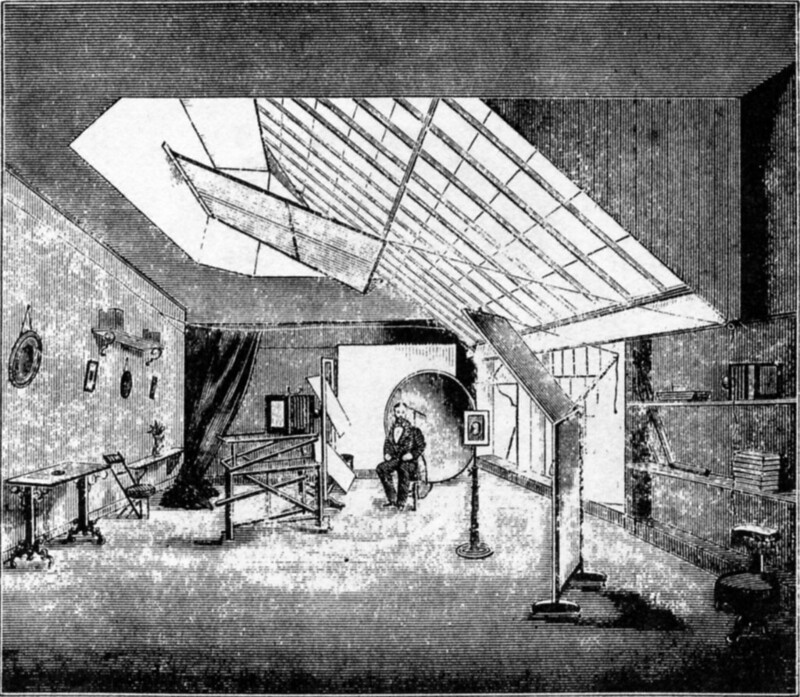
|
| The studio of Bradley and Rulofson of San Francisco (Image rights) |

|
| Sam Hood's studio[1] (Image rights) |
The early daguerreotype photography was optimal for achitecture because many early cameras had a kind of landscape lens which needed usage at small aperture, thus allowing only exposure times of ten minutes even in the sunshine. Soon there was a solution available, the fast Petzval lens which reduced exposure times to 30 seconds. This was still much time to keep still for the photographic model. Photographers had to avoid situations in which wind blew thru hair and dress of the portrayed person, or cold weather caused the model to shiver. Thus closed but light rooms were necessary, often wide rooms with glass roof. The Punch cartoon below shows a cat looking thru the studio's glass roof, the image above even a studio's whole glass roof. Seem to have been typical locations, with the artistic studio or "photographic studio" in a huge attic. The image above shows that mirrors, reflectors and diffusors may have been used to optimize the light falling onto the model.
Soon exposure times in bright light could be shortened by improving the applied photographic processes, but exposure times were still a few seconds. Thus the studio needed special equipment like chairs with small headrest and mise-en-scène furniture, pillars and stuff which also served as stilt on which the portrayed could rest. Some photographers even offered making photographs with huge background painting behind the portayed. When "Flashlight Lawrence" had made his efforts with magnesium powder flashes special tripod based studio flashes were developed soon. As well as bright gas lamps and last not least electric lamps.
oldtime studio
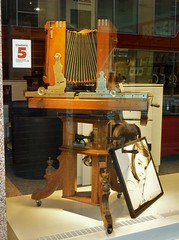
|
| studio camera image by Uwe Kulick (Image rights) |
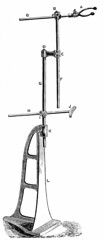
|
| head and back rest (Image rights) |
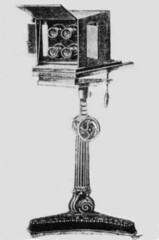
|
| CDV camera (Image rights) |
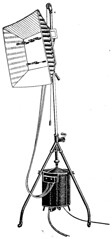
|
| carbon arc lamp (Image rights) |

|
| portrait lens image by Dirk HR Spennemann (Image rights) |

|
| studio flash (Image rights) |
modern studio
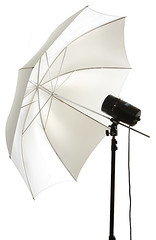
|
| electronic studio flash with semi-reflecting umbrella image by Raphael Borges (Image rights) |
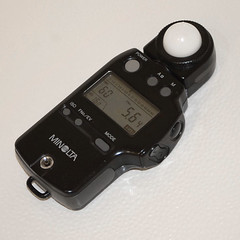
|
| flash meter image by Studioesper (Image rights) |
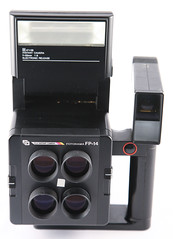
|
| passport camera image by Zebrio (Image rights) |
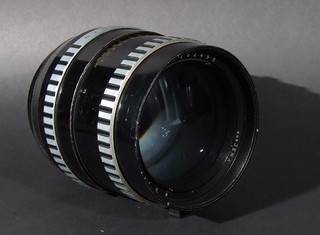
|
| portrait lens image by Süleyman Demir (Image rights) |
The artistic studio
let's have a look into some studios
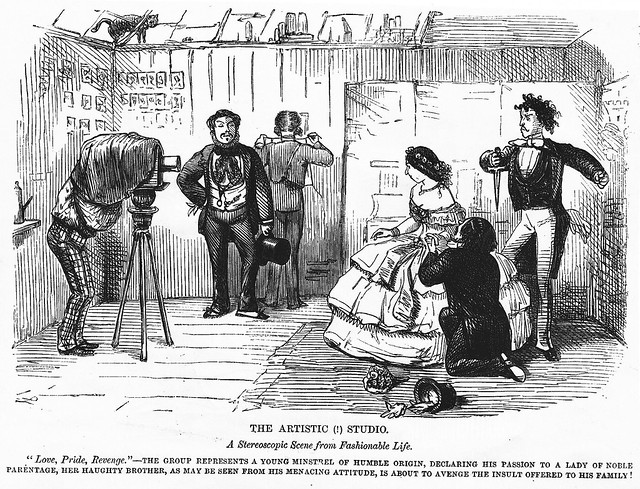
|
| cartoon from Punch magazine image by John Leech (Image rights) |
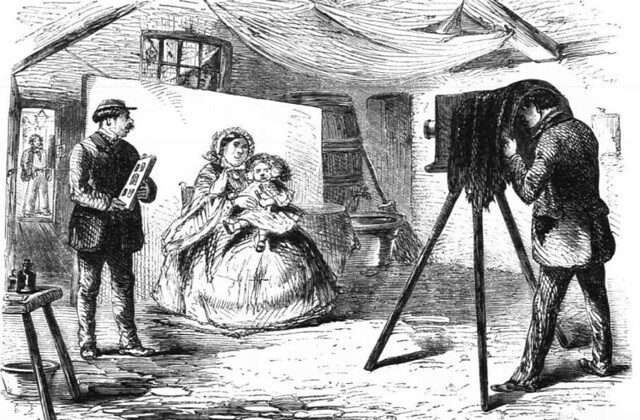
|
| Photographic Saloon, East End of London, 1861 by Henry Mayhew (Image rights) |
References and Links
- ↑ see Sam Hood's image collection in Library of New South Wales on Flickr